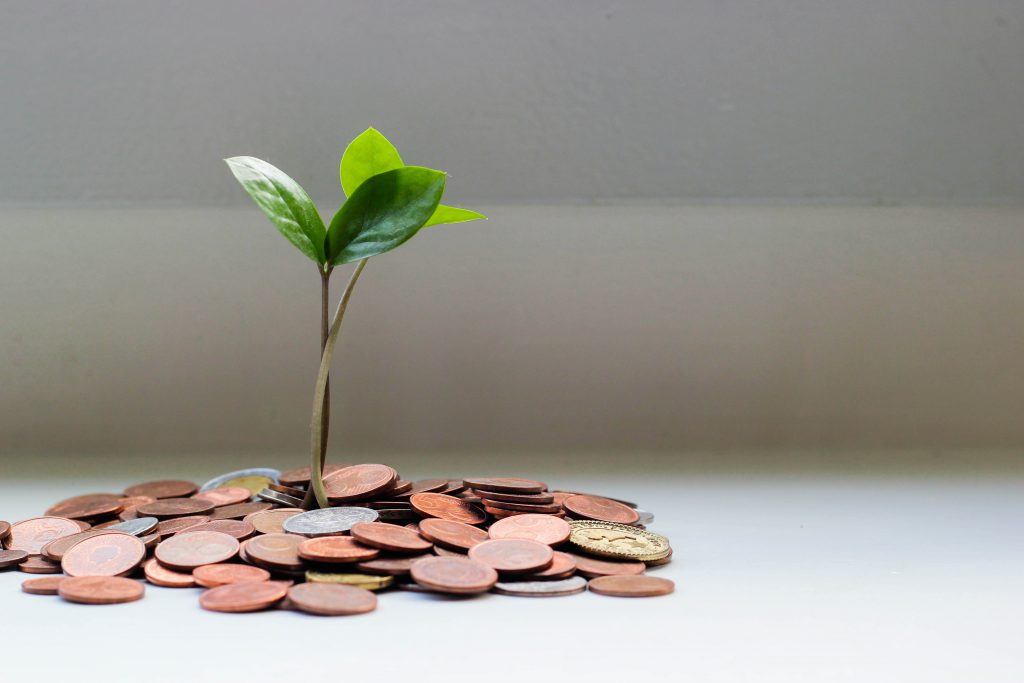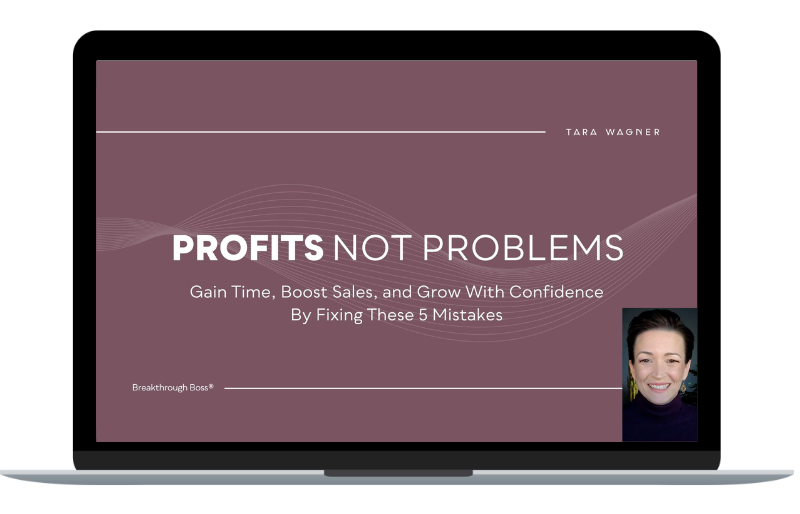You know you need a business savings account – but how much should go in it? And where should you invest it?
Read on to understand how to set a business savings goal, the only 2 things it should be used for, the 3 things to base it on, and the 4 steps to reach it.
Watch here or read on below.
Your business savings account or emergency fund is good for two things, is based around three things, and there are four things you should do to get it up to the right amount.
So let’s talk about all of those things plus what that right amount is.
What is a Business Savings Account?
Your business savings account is a separate account at your bank, separate from your taxes, separate from your business expenses, where you stockpile cold, hard cash that you can liquidate at a moment’s notice.
This should be used for two things.
- A rainy day fund
Your actual emergencies that you couldn’t or didn’t plan for. So this could be anything from natural disasters to pandemics. It could include things like fire or theft. It might include accidents or medical issues that keep you from working, keep you from being able to earn more money. It could also include lawsuits, a loss of inventory, or even something like a loss of ad accounts if your business is relying on those to bring in new customers or clients. - Additional savings above and beyond your emergency savings
Just to be used for great opportunities that might come along.
How much savings should I set aside?
So the main question that everybody asks is how much business savings should I have set aside for emergencies?
And this is based on three things.
- Your unique business expenses.
What’s the cost of operating your business? Should you not have revenue coming in? This means you might not include things like your cost of goods sold because you’re not going to be necessarily selling them. However, some people do like to include that. So we’ll talk about how to figure that in with a formula in just a second. - Your industry volatility or your own unique business volatility.
If there are a lot of things going on or could potentially be going on, even if it’s just personal things that make it very volatile, very difficult to go out and earn money, those things should be taken into account. - Good old peace of mind.
What’s your barometer for security? What’s going to make you feel good if you have that amount in the bank?
Comment below and let me know on a scale of one to 10, how comfortable are you taking risks? This is going to tell you how much savings you might want to have set aside.

The Formula
Okay, so I’ve written this into a formula. It looks scarier and more complicated than it actually is.
If we go through this step-by-step and if you grab a piece of paper and do this with me, it’s going to be much easier than it seems. So this is an actual formula to figure out how much money you need to have set aside in your business savings account is X * (V) + P + O. And what that is is Expenses * (Volatility) + Peace of Mind + Opportunities.
So let me show you how you figure this out. This is going to be really easy.
The first thing you need to know though is what are your actual business expenses?
Now, when you figure out your business expenses, if you haven’t, if you don’t have a budget, if you don’t know exactly what your expenses are yet, what you can do is just pull up your bank documents, your credit card documents, add things up. But what you’re probably going to want to do from that is subtract your COGS.
These are your Costs of Goods Sold. Now not everybody will subtract COGS. If you don’t know what COGS are, you probably don’t have them in your business. Not every business does. These are the things that you will only incur if you have an actual job or something sold. This is the Cost of the Goods Sold.
So this could be something like your subcontractors. This could be materials, things like that.
And for a lot of businesses, that’s worked into the price of the job. And so you don’t actually need to have that saved because when you have money coming in like a deposit coming in for the job, you’ll have the money for it.
However, some businesses need to have this ahead of time. So for instance, if you make clothing, you need to have your fabric and your things like that. So you may want to leave this in here. That’s up to you. What you’re wanting to do is figure out your expenses potentially remove the COGs from those expenses and remove your profit for salary maybe.
Now, should you include profit or salary and your business expenses?
That depends on whether or not you have a personal emergency fund set aside.
So what we do in our business is we have our own personal emergency fund. If we need to just stop paying ourselves, we would have money set aside in a personal emergency account to be able to pay our own salary, to pay our own personal bills or mortgage or groceries, things like that. Because of that, I don’t actually save this in my emergency fund, my business emergency fund.
If you don’t have that, or you want to be able to continue to pay yourself, you may want to include this as well.
Step 1 – Total Expenses
For step one, you’re going to want your total number of expenses.
Just for the sake of math, I’m going to make this really easy. Let’s pretend that your business expenses per month are $1,000. What you then want to do is times this by 3. So whatever your business expenses are, you’re going to times it by 3. And this is going to give you the first number that you need to know.
This is a really important number.
I want you to circle this one or do whatever you have to do to this one because we’re going to use this later on in just a minute.
This is the first savings goal that you have.
Step 2 – volatility
Now, what we want to do for step two is we want to figure out volatility.
What’s the volatility in your industry or your business?
- If you don’t really have volatility, maybe you’re just going to times this by 1, right? Which means you’re not going to do anything.
- If you’ve got a little bit of volatility, maybe you’re going to times it by one and a half.
- If you’ve got a lot of volatility, maybe you’re going to times it by four or somewhere in between.
You get to decide based on how volatile your industry is, maybe how seasonal it is as to how much money you actually want to have in addition to this.
So let’s pretend that you’re in a really volatile business. And we want to times this by 4. So this is going to give us a bigger savings goal of $12,000. This is your long-term emergency fund. This means if you didn’t have revenue for up to a year, you would be able to continue to pay your business expenses while you’re hustling your butt off, trying to figure out how to fix that revenue problem. Correct?
So that’s step number two. This is your big number, but you’re not done with this number yet.
Step 3 – Peace of Mind
The next thing you want to do is look at step three, which is peace of mind.
Peace of mind means: when you look at this number, whatever your step two number is, does that give you peace of mind? Does it feel like enough money set aside? Does it feel like too much money or not feel like enough and you want more set aside?
What you’re going to do with this is based on your peace of mind, based on how comfortable this number makes you feel, you’re going to either minus or add 20% to it.
So let’s say you were comfortable with this number. You would do nothing here. If this felt like too much, you would take 20% out of it, which would be $2,400, you would now be at $9,600. If it didn’t feel like enough, you would add 20% to it, which would be $14,400.
And so you decide here what this looks like based on your own personal peace of mind, your own sense of security.
Everybody’s a little bit different. Some people are more risk-averse. Some people are more risk-oriented. So you decide, “will I feel comfortable with this amount of money in the bank?”
Now, obviously, your number might be a lot more than this. So you might be looking at something like a $100,000 that’s just going to sit there, barely collect any interest and not do anything. And that might make you feel really uncomfortable. So maybe you’re going to decide, “okay, my number is actually going to be less than that, or it’s going to be $100,000 but I’m going to put 50 of it into a liquid emergency savings account. And I’m going to put 50 of it into something like a money market account”. There’s a little trick for you.
We’re going to talk more about whether or not you should invest it, but keep that in mind. If you’ve got a big number you’ve got flexibility.
Now let’s pretend that you did drop it down to the $9,600.
Step 4
Now what you want to do is step four. You want to add 10 to 20% just for opportunities.
So let’s just say, we’re just going to add $1,000, cause I’m not going to add up 960 to that number. So we’re just gonna move this up to almost $11,000, right? This is your final number.
Now what I’m going to talk about next is which you need to focus on, which comes first, and how to increase your savings in a way that is going to be fast and effective, but also sustainable as well. So let’s talk about that next.

How do I save that much?
So now let’s talk about a couple of strategies to help you get to those savings numbers as quickly and as painlessly as possible.
The first thing that it’s really important to do is create an actual budget. This is going to allow you to reign in any sneaky spending and funnel every last dollar into your emergency fund that you possibly can.
I have two videos on how to make a budget.
One of them is the simplified five-minute budget. This one’s okay, but it’s probably not what you’re going to want when it comes to being able to save as many dollars as you can.
The one you’re probably going to want is this one, How to Create a Business Budget Using a Software Like YNAB. This is going to really show you how to be able to cut those expenses, track every last dollar, and funnel everything you can into your business savings account.
Now to reach those savings numbers, we’re going to do this Dave Ramsey style with some baby steps.
Baby Steps
The first thing that I want you to do is set a 30-day goal to reach a thousand dollars in your business savings account.
Now, why a 30-day goal? Because we want to get there as quickly as possible. And we want to get creative to do it. It doesn’t matter where this money is coming from, just matters where it’s gonna end up.
This money can come from things you do inside your business, like promotions or sales that you’re going to run just for this purpose. It could be things that you do outside of your business, like selling stuff around the house, just to funnel that money and get that first thousand dollars saved. This first $1,000 is crucial. This is what’s going to help you start to get ahead because most little emergencies that come up are little. There are things that can be paid for in under $1,000 dollars.
Now we’re going to do something a little bit different for your 3-month number that you figured out in that formula. We’re going to set a target date for this, and we’re going to break it down into a manageable monthly bill.
Now, when I say manageable, this shouldn’t really cause you pain to be able to reach this number every month, but it is okay if it stretches you as long as you’re comfortable, you’re in a season of business or you’re just feeling ready for that stretch. That’s okay.
So let’s say your 3-month number was $10,000. You wanted to get this in 10 months, you were going to do $1,000 a month. Is that $1,000 manageable for you? Could you swing that on a regular monthly basis? If not, change your target date so that you can get a more manageable number.
You can always do something like $500 is your target number. And you can blow that out of the water any month, you have a good month. But this is going to ensure that this process is not stressful and that you can continue to actually move towards it and not give up out of frustration.
The next thing that you need to do is automate that transfer.
Whatever that manageable monthly bill amount is, you need to set it up so that’s an automatic transfer from your business checking to your business savings every single month.
We’re doing this because we want to get it out of our brain, that this is optional. We want to treat this like a bill. And if it’s going to happen automatically, we’re going to do our best to make sure that we have the money set aside for it.
So you figure out what day of the month, this needs to happen. You figure out what you need to do to get that money into your account so that it can make that transfer. And then you take it off your mind that this is optional. Treat it like a bill, like a debt you have to pay so that you can get to that number faster.

Now, some tips to help you get there faster.
Number one, use that budget to help you cut some expenses.
What are the things that you’re currently paying for that are nice to have, but aren’t actually necessary to running your business? At least not right now. You can put them off until you get to that 3-month number.
This could be anything from trainings that you want to take, events that you want to go to, to maybe software that you need to change around or decrease so that you can funnel a little bit extra towards that bill.
Next, take a pay cut.
Think of this, like paying your future self. Your future self is gonna be so happy when an emergency hits that they don’t have to take a pay cut out of force. They took one now out of choice, doing it because you choose to do it is always going to feel better than doing it because you have to do it.
Next, anytime you have a windfall, anytime you have a really good month in your business, do not take that as profit.
Take some money aside for taxes and put all of the rest of it into your business savings account. Just for that peace of mind, just so that you can get to that number faster.
And lastly, what can you do to earn more money?
We can only decrease our expenses so much. We can only save so much. We’ve got to outearn ourselves. So what can you do to increase the revenue in your business?
That’s the primary focus of all the other things you should be looking at, everything else, taking a pay cut, decreasing expenses. Those are things that you do one time at the beginning of this. And then your primary goal is what can I do to earn more money so that I can stock pilot for savings later?
I also want to mention, it might be time to look at whether or not you need to increase your prices just because you want to earn more money doesn’t mean you should increase your prices. So what I would actually do is check out this playlist on pricing to get a better idea of whether or not it’s the right time for you.
Now, once you hit your 3-month goal, we’re going to take that bigger savings goal and we’re going to do basically the same thing, but we’re going to do it in a little bit less of a stressful way.
We want to make sure that this is sustainable. So we want to do the same thing, set a target date and set a manageable monthly bill. But now you want that manageable monthly bill to be a little bit smaller. So it’s not so much of a stress on you.
You can start taking a salary again. You can stop feeling like you’re pinched just to get money saved.
Now, this doesn’t have to be something you do. If you want to keep going gung ho for a while, you absolutely can. But my goal here is to make sure that you can sustain this monthly bill and that it’s not something that’s making you feel so deprived now that you end up blowing through money, just because of a knee-jerk reaction.
If we deprive ourselves too long of the fruits of our labor, we end up going on a spending spree. I don’t want that to happen.
So I want you to look at this: “I have my 3 months set aside. I need to still get up to that bigger number, but what’s a more manageable, sustainable way for me to do so?” And then you’re going to do the same things. You’re going to automate that number. You’re going to focus on increasing your revenue and you’re going to focus on just saving as much as you can, that is comfortable now to do so that doesn’t feel like so much of a pinch.
Should I invest my emergency savings?
The final question that we all ask is what should I do with this money? Should I invest it into a money market, CDs, even the stock market? And the answer to this is, Nope.
I know it’s going to hurt to have this big chunk of money just sitting there and not earning anything. And if you can get a high yield savings account, definitely do so. However, those change all the time, and chasing savings accounts is generally not worth your time.
What’s worth your time is making more money, right?
So don’t worry about that, this business savings account, your emergency fund needs to stay liquid. You need to be able to tap into it at a moment’s notice. So I even like to have this at a local bank or the same bank that I have my business expenses at so that it can transfer back in should I need to. It needs to be liquid and easy to get to. It needs to be fast to get to there shouldn’t be any delay. There shouldn’t be any penalties for taking it out.
This is your emergency fund. It’s not going to be earning you anything. It’s going to be giving you peace of mind and saving your butt down the road. That’s the real investment here.
Again, I don’t want you to stress yourself out about trying to save, save, save. What I really want you to be focusing on is what can I do to earn, earn, earn? What can I do to increase my business revenue, to get this savings up to where I want it to be?
Get your healthy hustle on…
As always, if you need help figuring out how to increase your business profits so that you can do things like build your business savings account I highly recommend you check out my Healthy Hustle Roadmap.
My free class, How to Use a Holistic Approach to Create a Profitable Business Without Burning Yourself Out will teach you the three mistakes small business owners are making and introduce you to the strategies I teach that will help you to create a profitable business you can rely on in under 40 hours a week. You can grab your seat for the free class by clicking the button below.
What about you, boss lady?
I’d love to hear from you! Do you have a business savings account?
Scroll down to leave your comments below!




